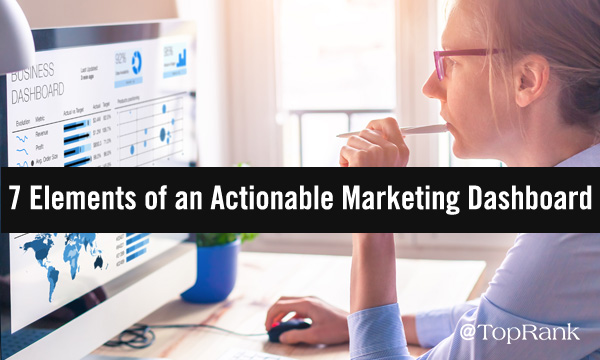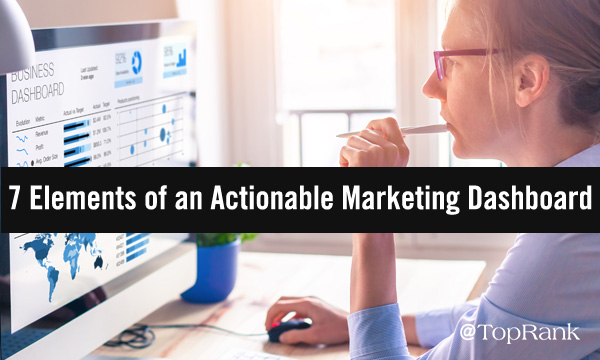And this is why an actionable content marketing dashboard is so incredibly important. When properly set up, an actionable dashboard marries data and insight, helping you quickly see how you’re performing against your benchmarks, goals, and key performance indicators (KPIs), and where you have opportunities to improve results or need to dig deeper. What Makes a Marketing Dashboard Actionable? For a content marketing dashboard to be actionable, it has to answer two simple questions: Is what we’re doing working? You’ll be able to tell if your content is more or less visible for your target, or if your content marketing strategy needs to shift to meet a different type of demand for that topic. Make sure you’re monitoring your bounce rate and time-on-page for each post to determine if the content is resonating and adjust as needed. If your data is accurate and your dashboard is actionable, you’re in the right place to start creating and marketing incredible content that has proven ROI and helps your sales team meet their goals. You may set it up in one way and realize that the KPIs and metrics you have aren’t the ones you need, and that’s okay. The more time you spend digging into data up front and understanding the finer points, the better equipped you’ll be to answer questions and provide insights into remaining questions. Annotations will save you from having to dig into your notes, emails or previous campaign data every time it pops up in a report.

Hey, content marketers. Imagine this: You’re sitting in a marketing meeting and you hear the following:
- Our conversions are up 50% year-over-year!
- Our blog traffic is down.
- We saw a big spike in traffic this month to our primary service page!
- Our bounce rate is all over the place.
- This blog post about “X” had 2,000 page views last month!
What are the first thoughts that come to mind? For many, the first thought would likely be: Why? Followed by a: Is that good or bad? And then finally: What do we need to do next?
If you’ve ever experienced a similar scenario, you’ve come face-to-face with insight famine. The statements above simply relay data points and lack the insight needed to take any sort of action. And this is why an actionable content marketing dashboard is so incredibly important.
When properly set up, an actionable dashboard marries data and insight, helping you quickly see how you’re performing against your benchmarks, goals, and key performance indicators (KPIs), and where you have opportunities to improve results or need to dig deeper.
What makes a dashboard actionable? What key data and insight elements should be included? Let’s dig in.
What Makes a Marketing Dashboard Actionable?
For a content marketing dashboard to be actionable, it has to answer two simple questions:
- Is what we’re doing working?
- Why is it (or is it not) working?
In order to answer those questions, there are specific metrics to include based on your overall objectives. For example, if your objective is to drive qualified leads for your sales team, you might measure the amount of inquiries that resulted from a piece of content, how many of those inquiries turned into MQLs, then SQLs, then ultimately customers.
If you apply those metrics to each piece of content, you’ll quickly see which content is hitting the mark, and what needs to be adjusted. And if your objective varies by topic cluster or funnel stage, you’ll need different sets of KPIs for each.
7 Essential Elements of an Actionable Marketing Dashboard
So, how do we answer those two simple questions posed above? There are several key components to consider including in your dashboard:
#1 – Content Benchmarks
Benchmarks are essential for understanding how different types of content have performed on average over a specific period of time. Your benchmarks can and should be different based on the content type and its objective.
For example, a top-of-funnel blog post meant to drive traffic will have a different benchmark than a middle-funnel infographic meant to engage. By keeping these front-and center in your marketing dashboard, you can compare at-a-glance.
#2 – Goals
More than likely your goals are to beat your benchmarks every single time. But it’s important to document your goals so you can gauge success. By adding your goals to your marketing dashboard, you can quickly determine whether you’re on pace to hit your goal and if you’ve been able to surpass it.
And ultimately, keeping that data within your dashboard will help you course-correct where needed and celebrate wins as they occur.
#3 – Real-Time KPI Monitoring
Depending on your objective for the content…

COMMENTS